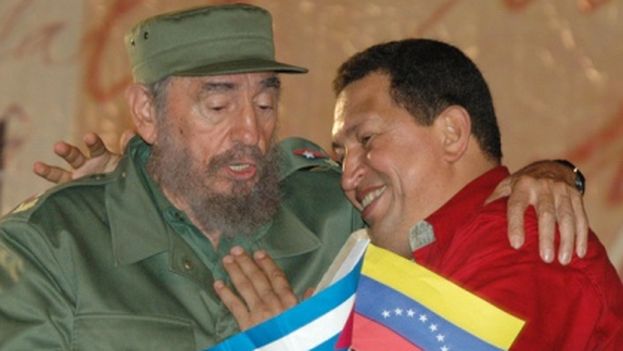
14ymedio, Carlos Alberto Montaner, 31 January 2016 – Let’s get right down to it. The current conflict that divides half the planet, and especially Latin Americans, is between neo-populism and authoritarian democracy, against liberal democracy. I just developed a short course on the subject at the Francisco Marroquín University in Guatemala. I do not know any other institution so committed to economic and political freedom. Impressive.
In the neo-populist corner of the ring appear, to the left, Father Marx, statism, cronyism, Liberation Theology, the Dependency Theory, Eduardo Galeano, Che Guevara, Ernesto Laclau, Hugo Chavez, Evo Morales, Fidel Castro, all mixed up, plus the other issues: long-lasting caudillos, excessive public spending, ALBA, 21st Century Socialism, the Sao Paulo Forum and a tense et cetera with a closed fist and a street slogan on its lips.
In the liberal corner we find Father Adam Smith, Ludwig von Mises, Hayek and the Austrians, Milton Friedman and the market, James Buchanan and the School of Public Choice, Douglas North and the institutionalists, individual responsibility, private enterprise, the Rule of Law, FTAA, free global trade, the Asian Tigers, the successful Chilean reform, Ronald Reagan, Margaret Thatcher, Mario Vargas Llosa, and the small and efficient state.
This axis of confrontation is relatively new.
The 19th century was about old-fashioned liberals against conservative, also old-fashioned. The 20th saw, first, the battle between the supposed virtues of Hispanic identity against the defects of the Anglo-Saxons (José Enrique Rodó’s Ariel and the incendiary lectures of Manuel Ugarte). The 1910 Mexican Revolution simmered in the anti-imperialist sauce.
Following this was the appearance of Marxism and fascism, cousins who ended up looking very much alike. The Twenties were those of the Argentine psychiatrist José Ingenieros, with his soul and umbrellas both red, and those of José Carlos Mariátegui and his Seven Interpretive Essays on the Peruvian Reality.
Soon after, in Mussolini’s Italy, a young Argentinean soldier observed the fascist experience with admiration. His name was Juan Domingo Perón and on his return to Buenos Aires he launched his “Third Way.” Neither communism nor capitalism: Justicialism. That is, Peronism, pure and simple. It was the Creole expression of fascism.
The Cold War followed immediately on World War II. Before and after Latin American was filled with sword-bearers sanctified by Washington. The axis of confrontation then passed through the barracks against the communist, or everything that smelled of them.
In the Forties another force broke through: the democratic left. They began to triumph in Guatemala (Juan José Arévalo), Costa Rica (José Figueres), Cuba (Carlos Prío), Venezuela (Rómulo Betancourt) and Puerto Rico (Luis Muñoz Marín). They were democratic anti-communists who came from the left. They fought against militarism from anti-communist positions.
They also constituted a soft vegetarian variant of populism. They believed in the paternalistic welfare state and did not reject statist measures. Reigning in the economic field was his majesty Lord Maynard Keynes and politicians who were using the national budget and public spending to boost the economy. Wonderful. They were intellectually entitled to squander fortunes. Simultaneously, they distributed profits and executed land reforms that almost never achieved their objectives.
In 1959 the badge of the struggle changed again. Fidel and Raúl Castro, along with Che Guevara and with the innocent help of other democratic groups, overthrew the “soft” military dictatorship of Batista, with the objective of establishing a communist dictatorship copied from the Soviet model. They proposed, essentially, to destroy the governments of the democratic left, defining the adversary by its relations with the United States and with property.
If you were pro-American and pro-market, even if you were leftist and respected freedoms, you were the enemy. Cuba attacked Uruguay, Venezuela, Peru, Panama, everything that moved and breathed. Also, of course, the old military dictators like Somoza, Trujillo and Stroessner, but not for being tyrants, but for being pro-American and pro-capitalist. The island was “a nest of machine guns in motion.” The United States joined the war in 1965; in the midst of a civil war Marines landed in the Dominican Republic in order, they said, “to avoid another Cuba.”
With Allende in 1970 the dangerous game of authoritarian democracy began and it ended three years later in a hail of bullets. Pinochet, who was Allende’s man, or so Mr. Allende believed, ended up bombing him. However, as the general didn’t know a single thing about economics, he handed off these mysterious activities to some young Chileans who had graduated from the University of Chicago and Harvard. Soon they began to turn the situation around.
It was the first time Latin America heard of Friedrich Hayek (Nobel Prize in 1974), or Milton Friedman (1976). In the mid-eighties it was clear that populism had plunged Latin America into a pool of corruption, unbridled inflation and unrestrained public spending. The region had failed. They spoke then of the “lost decade.”
Thus arose the first liberal cycle in Latin America. Its main protagonists came from another ideological quarry, but they were flexible and intelligent people. Among others, included the Bolivian Victor Paz Estenssoro, who returned to power in 1985 to fix the mess of 1952, the Costa Rican Oscar Arias, the Argentine Carlos Menem, Mexico’s Carlos Salinas de Gortari, the Colombian Cesar Gaviria and the Uruguayan Luis Alberto Lacalle.
More than liberal convictions propelled the certainty of populist failure. Unfortunately, accusations of corruption against Salinas and Menem, plus the excessive increase in public spending in Argentina, discredited that liberal reform and its enemies began to effectively attack “the long neo-liberal night.”
In 1999, finally, Hugo Chávez began to govern and he initiated another phase of authoritarian democracy. This has now come to its end, sunk in poverty, with shortages and corruption, giving way to the new cycle of liberal democracy, that perhaps started with the Mauricio Macri’s victory in Argentina. Let’s hope it lasts.
